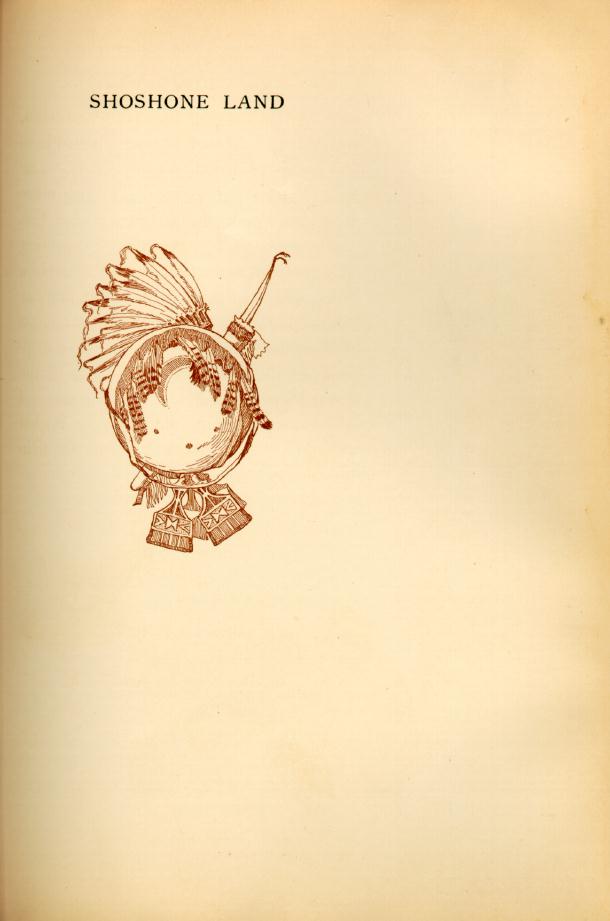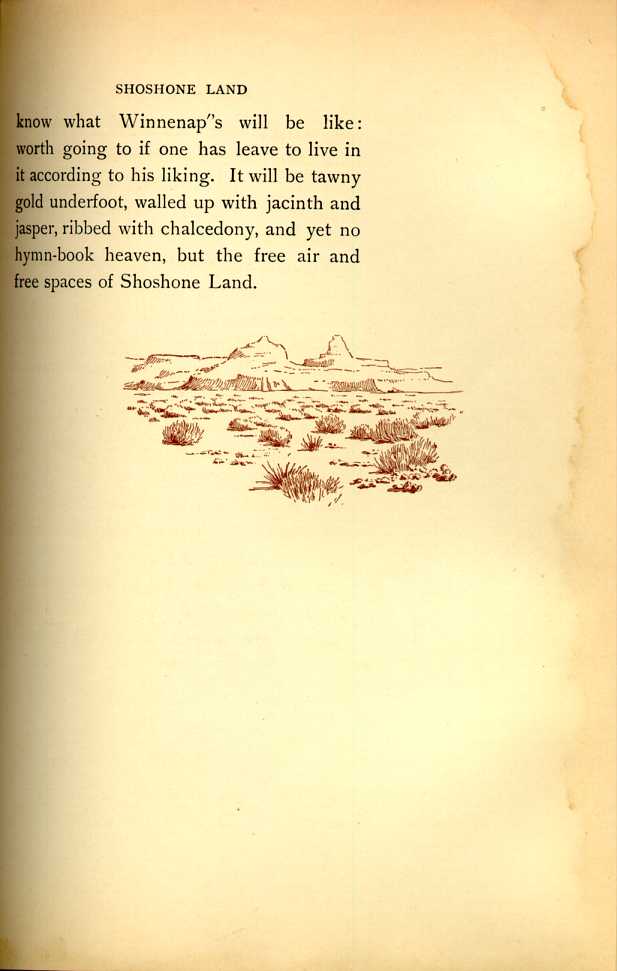|
SHOSHONE LAND The Land of Little Rain | ||
5. SHOSHONE LAND
It is true I have been in Shoshone Land, but before that, long
before, I had seen it through the eyes of Winnenap' in a rosy mist
of reminiscence, and must always see it with a sense of intimacy in
the light that never was.
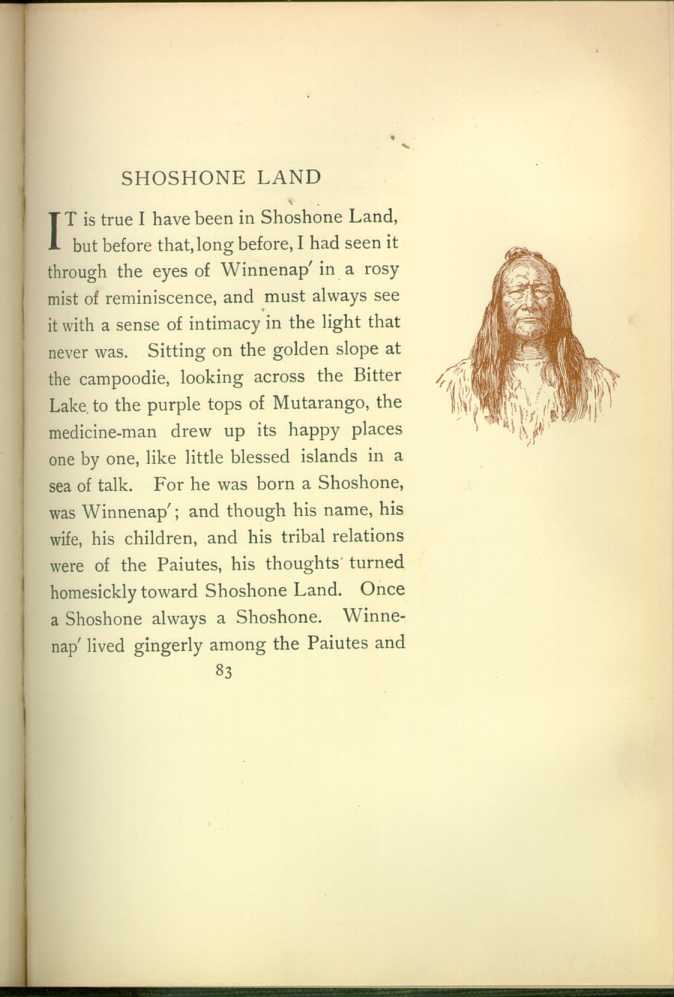 [Description:
In the right margin, a brown-toned line-drawing portrait of a native
American man, presumably Winnenap'. His face is lined, he looks
directly at the viewer, and his hair is long and pours down over his
chest. He wears a fringed top, possibly made of suede. The fringes
come down off the shoulders and meet in a V on his chest.
]
[Description:
In the right margin, a brown-toned line-drawing portrait of a native
American man, presumably Winnenap'. His face is lined, he looks
directly at the viewer, and his hair is long and pours down over his
chest. He wears a fringed top, possibly made of suede. The fringes
come down off the shoulders and meet in a V on his chest.
]
He had come into the keeping of the Paiutes as a hostage for the long peace which the authority
To reach that country from the campoodie, one goes south and south, within hearing of the lip-lip-lapping of the great tideless lake, and south by east over a high rolling district, miles and miles of sage and nothing else. So one comes to the country of the painted hills,—old red cones of craters, wasteful beds of mineral earths, hot, acrid springs, and steam jets issuing from a leprous soil. After the hills the black rock, after the craters the spewed lava, ash strewn, of incredible thickness, and full of sharp, winding rifts. There are picture writings carved deep in the face of the cliffs to mark the way for those who do not know it. On the very edge of the black rock the earth falls
South the land rises in very blue hills, blue because thickly wooded with ceanothus and manzanita, the haunt of deer and the border of the Shoshones. Eastward the land goes very far by broken ranges, narrow valleys of pure desertness, and huge mesas uplifted to the sky-line, east and east, and no man knows the end of it.
It is the country of the bighorn, the wapiti, and the wolf, nesting place of buzzards, land of cloud-nourished trees and wild things that live without drink. Above all, it is the land of the creosote and the mesquite. The mesquite is God's best thought in all this desertness. It grows in the open, is thorny, stocky, close grown, and iron-rooted. Long winds move in the draughty valleys, blown sand fills and fills about the lower branches, piling pyramidal dunes, from the top of which the mesquite twigs flourish greenly. Fifteen or twenty feet under the drift, where it seems no rain could penetrate, the main trunk grows, attaining often a yard's thickness, resistant as oak. In Shoshone Land one digs for large timber; that is in the southerly, sandy exposures. Higher on the table-topped ranges low trees of juniper and pinon stand each apart, rounded and spreading heaps of greenness. Between them, but each to itself in smooth clear spaces, tufts of tall feathered grass.
This is the sense of the desert hills, that there is
The manner of the country makes the usage of life there, and the land will not be lived in except in its own fashion. The Shoshones live like their trees, with great spaces between, and in pairs and in family groups they set up wattled huts by the infrequent springs. More wickiups than two make a very great number. Their shelters are lightly built, for they travel much and far, following where deer feed and seeds ripen, but they are not more lonely than other creatures that inhabit there.
The year's round is somewhat in this fashion. After the pinon harvest the clans foregather on a warm southward slope for the annual adjustment of tribal difficulties and the medicine dance, for marriage and mourning and vengeance, and the exchange of serviceable information; if, for example, the deer have shifted their feeding ground, if the wild sheep have come back to Waban, or certain springs run full or dry. Here the Shoshones winter flockwise, weaving baskets and hunting big game driven down from the country of the deep snow. And this brief intercourse is all the use
When the rain is over and gone they are stirred by the instinct of those that journeyed eastward from Eden, and go up each with his mate and young brood, like birds to old nesting places. The beginning of spring in Shoshone Land—oh the soft wonder of it!—is a mistiness as of incense smoke, a veil of greenness over the whitish stubby shrubs, a web of color on the silver sanded soil. No counting covers the multitude of rayed blossoms that break suddenly underfoot in the brief season of the winter rains, with silky furred or prickly viscid foliage, or no foliage at all. They are morning and evening bloomers chiefly, and strong seeders. Years of scant rains they lie shut and safe in the winnowed sands, so that some species appear to be extinct. Years of long storms they break so thickly into bloom that no horse treads without crushing them. These years the gullies of the hills are rank with fern and a great tangle of climbing vines.
Just as the mesa twilights have their vocal note
Now as to these same Shoshones there are some who claim that they have no right to the name, which belongs to a more northerly tribe; but that is the word they will be called by, and there is no greater offense than to call an Indian out of his name. According to their traditions and all proper evidence, they were a great people occupying far north and east of their present bounds, driven thence by the Paiutes. Between the two tribes is the residuum of old hostilities.
Winnenap', whose memory ran to the time when the boundary of the Paiute country was a dead-line to Shoshones, told me once how himself and another lad, in an unforgotten spring, discovered a nesting place of buzzards a bit of a way beyond the borders. And they two burned to rob those nests. Oh, for no purpose at all except as boys rob nests immemorially, for the fun of it, to have and handle and show to other lads as an exceeding treasure, and afterwards discard. So, not quite meaning to, but breathless with daring, they crept up a gully, across a sage brush flat and
The medicine-man told me, always with a quaking relish at this point, that while they, grown bold by success, were still in the tree, they sighted a Paiute hunting party crossing between them and their own land. That was mid-morning, and all day on into the dark the boys crept and crawled and slid, from boulder to bush, and bush to boulder, in cactus scrub and on naked sand, always in a sweat of fear, until the dust caked in the nostrils and the breath sobbed in the body, around and away many a mile until they came to their own land again. And all the time Winnenap' carried those buzzard's eggs in the slack of his single buckskin garment! Young Shoshones are like young quail, knowing without teaching about feeding and hiding, and learning what civilized children never learn, to be still and to keep on being still, at the first hint of danger or strangeness.
As for food, that appears to be chiefly a matter of being willing. Desert Indians all eat chuckwallas, big black and white lizards that have delicate white flesh savored like chicken. Both the Shoshones and the coyotes are fond of the flesh of Gopherus agassizii , the turtle that by feeding on buds, going without drink, and burrowing in the sand through the winter, contrives to live a known
Next to spring, the best time to visit Shoshone Land is when the
deer-star hangs low and white like a torch over the morning hills.
Go up past Winnedumah and down Saline and up again to the rim of
Mesquite Valley. Take no tent, but if you will, have an Indian
build you a wickiup, willows planted in a circle, drawn over to an
arch, and bound cunningly with withes, all the leaves on, and
chinks to count the stars through.
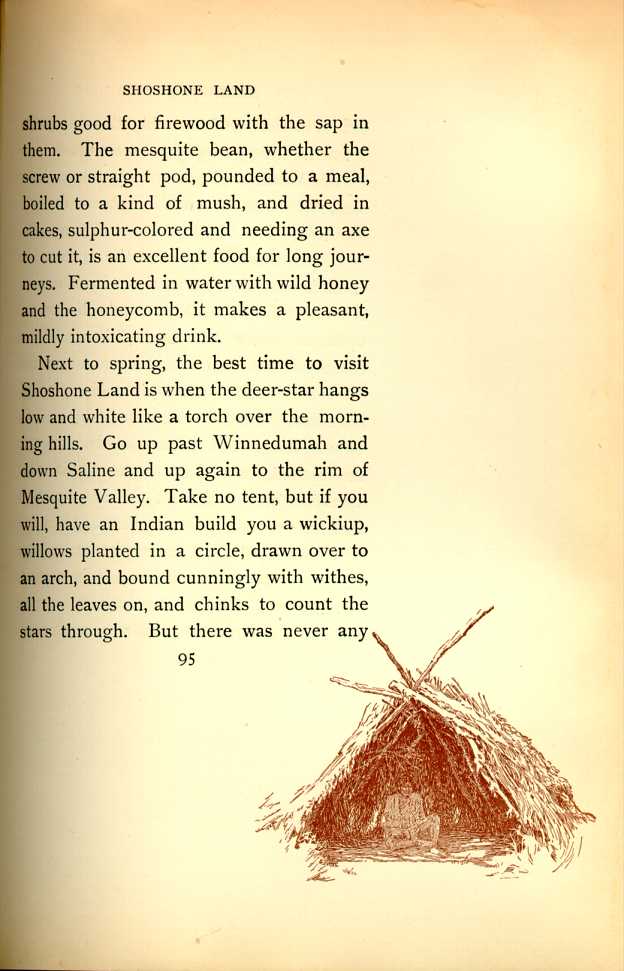 [Description:
A brown-toned line-drawing of a wickiup, "willows planted in a circle,
drawn over to an arch, and bound cunningly with withes, all the
leaves on, and chinks to count the stars through."
]
[Description:
A brown-toned line-drawing of a wickiup, "willows planted in a circle,
drawn over to an arch, and bound cunningly with withes, all the
leaves on, and chinks to count the stars through."
]
And Winnenap' will not any more. He died, as do most medicine-men of the Paiutes.
Where the lot falls when the campoodie chooses a medicine-man there it rests. It is an honor a man seldom seeks but must wear, an honor with a condition. When three patients die under his ministrations, the medicine-man must yield his life and his office. Wounds do not count; broken bones and bullet holes the Indian can understand,
It is possible the tale of Winnenap''s patients had not been strictly kept. There had not been a medicine-man killed in the valley for twelve years, and for that the perpetrators had been severely punished by the whites. The winter of the Big Snow an epidemic of pneumonia carried off the Indians with scarcely a warning; from the lake northward to the lava flats they died in the sweat-houses,
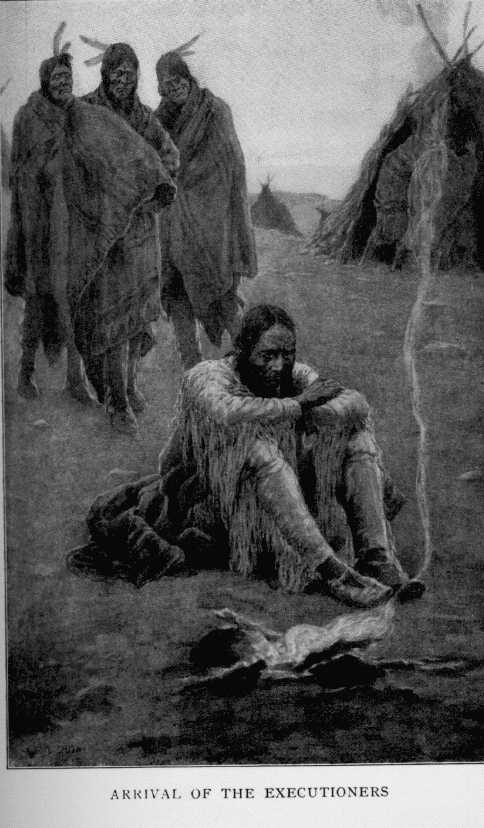 [Description:
Caption: "Arrival of the Executioners." A black and white photo of
possibly a watercolor showing Winnenap' sitting by a fire, awaiting
the approach of the three tribesmen who have sentenced him to death
for not curing the bout of pneumonia. The fire is at center right
foreground, smoking into thr sky, and Winnenap' sits behind it, facing
the viewer. He wears a heavily fringed set of pants and top, and his
arms are folded , his elbows resting on his drawn up knees. Three
Paiutes wearing blanket robes stand at top left, approaching Winnenap'
from behind. Each has two feathers in his headdress. At top right is
a teepee made of skins laid on a frame.]
[Description:
Caption: "Arrival of the Executioners." A black and white photo of
possibly a watercolor showing Winnenap' sitting by a fire, awaiting
the approach of the three tribesmen who have sentenced him to death
for not curing the bout of pneumonia. The fire is at center right
foreground, smoking into thr sky, and Winnenap' sits behind it, facing
the viewer. He wears a heavily fringed set of pants and top, and his
arms are folded , his elbows resting on his drawn up knees. Three
Paiutes wearing blanket robes stand at top left, approaching Winnenap'
from behind. Each has two feathers in his headdress. At top right is
a teepee made of skins laid on a frame.]
After two weeks of this plague the Paiutes drew to council to consider the remissness of their medicine-men. They were sore with grief and afraid for themselves; as a result of the council, one in every campoodie was sentenced to the ancient penalty. But schooling and native shrewdness had raised up in the younger men an unfaith in old usages, so judgment halted between sentence and execution. At Three Pines the government teacher brought out influential whites to threaten and cajole the stubborn tribes. At Tunawai the conservatives sent into Nevada for that pacific old humbug, Johnson Sides, most notable of Paiute orators, to harangue his people. Citizens of the towns turned out with food and comforts, and so after a season the trouble passed.
But here at Maverick there was no school, no oratory, and no alleviation. One third of the campoodie died, and the rest killed the medicine-men. Winnenap' expected it, and for days walked and sat a little apart from his family that he might meet it as became a Shoshone, no doubt suffering the agony of dread deferred. When finally three men came and sat at his fire without greeting he knew his time. He turned a little from them, dropped his chin upon his knees, and looked out over Shoshone Land, breathing evenly. The women
So much has the Indian lost of savageness by merely desisting from killing, that the executioners braved themselves to their work by drinking and a show of quarrelsomeness. In the end a sharp hatchet-stroke discharged the duty of the campoodie. Afterward his women buried him, and a warm wind coming out of the south, the force of the disease was broken, and even they acquiesced in the wisdom of the tribe. That summer they told me all except the names of the Three.
Since it appears that we make our own heaven here, no doubt we shall have a hand in the heaven of hereafter; and I know what Winnenap''s will be like: worth going to if one has leave to live in it according to his liking. It will be tawny gold underfoot, walled up with jacinth and jasper, ribbed with chalcedony, and yet no hymnbook heaven, but the free air and free spaces of Shoshone Land.
|
SHOSHONE LAND The Land of Little Rain | ||
